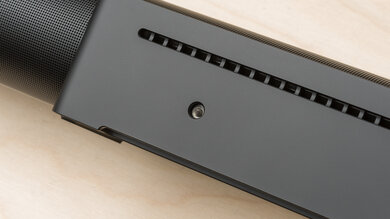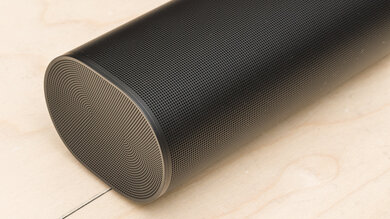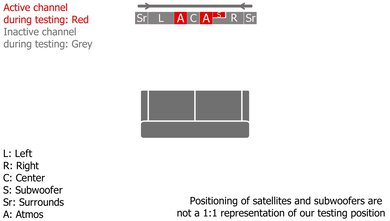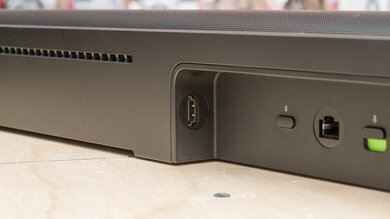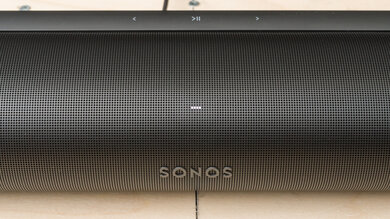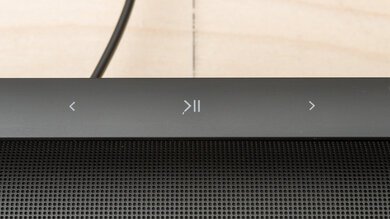The Sonos Arc Ultra is Sonos' flagship 2024 standalone soundbar. It treads in the footsteps of the 2020 Sonos Arc, but builds on its footprint by revamping the acoustic architecture. With the new 'Sound Motion' built-in subwoofer and an array of front, side, and up-firing drivers, the manufacturer claims it can reproduce a 9.1.4 Dolby Atmos experience with an all-in-one bar. There have been improvements on the connectivity front, with Bluetooth as standard, plus the ability to connect Sonos Era 100 or Sonos Era 300 speakers to expand the surround sound possibilities. So, have Sonos raised the (all-in-one) bar with their latest home theater offering?
Our Verdict
The Sonos Arc Ultra is good for mixed usage. It has a balanced default sound profile that lends itself particularly well to dialogue-driven TV shows, aided by its discrete center. While there's an impressive amount of bass present for a standalone bar, it still doesn't render sub-bass wobbles and earth-shaking sound effects as intensely as a dedicated subwoofer. It can get plenty loud without compressing much, ensuring audio remains clean and pure, even at max volume. It's compatible with most major audio formats, including Dolby Atmos and DTS. Bluetooth compatibility arrives to complement existing Wi-Fi and AirPlay integration, ensuring this bar plays well with your other devices (especially the Sonos ones).
Sleek and sturdy design.
Lots of wireless connectivity options.
TruePlay room correction feature.
Compatible with most popular audio formats.
Minimal compression at max volume.
No graphic EQ or presets.
No full HDMI In.
The Sonos Arc Ultra is impressive for dialogue and TV shows. It does a great job of rendering mid-range content with detail and clarity, so dialogue and speech sound crisp and natural. The discrete center channel ensures great localization of dialogue, adding a sense of space to witty repartee. There are even three levels of voice enhancement to better aid intelligibility. There's no need to worry about audio clarity suffering at higher volumes, either. The great dynamics performance ensures voices sound clean and pure, even at max volume.
Sleek and sturdy design.
Compatible with most popular audio formats.
Minimal compression at max volume.
No graphic EQ or presets.
The Sonos Arc Ultra is great for music. The integrated Sound Motion subwoofer is capable of outputting much more bass than the average standalone bar, injecting punch and thump into kicks and basslines, though it doesn't quite have the same rumble you'd get from a discrete sub. The mid and treble ranges are very well-balanced, ensuring vocals and lead instruments sound detailed and clear within a wide soundstage. There's plenty of volume on tap for your next house party and very little compression, even at max volume. Bass and treble adjustment sliders are welcome additions, as are the DSP sound modes, but the lack of a more granular EQ will disappoint some.
Lots of wireless connectivity options.
TruePlay room correction feature.
Minimal compression at max volume.
No graphic EQ or presets.
The Sonos Arc Ultra is decent for movies. While the integrated subwoofer punches above its weight, there's not much low-end rumble to go with the punch, which can make action-packed sequences less of a sensory experience. The balanced mid-range and discrete center channel ensure the nuances of movie dialogue are well-preserved, and the soundstage is wide and immersive sounding. With Atmos content, the up and side-firing drivers help expand the sound field outwards and upwards, but tracking and localization naturally fall short of a discrete setup. Fortunately, you can integrate Sonos Era 100 or 300 speakers for a more immersive Atmos experience.
Compatible with most popular audio formats.
Minimal compression at max volume.
No graphic EQ or presets.
Height performance leaves something to be desired.
Changelog
-
Updated Oct 24, 2025:
We mentioned the KEF XIO in the Height (Atmos) section of this review.
-
Updated Sep 18, 2025:
This review was updated to mention the Klipsch Flexus Core 300 in Audio Format Support: ARC/eARC box.
-
Updated Jul 30, 2025:
We added a reference to the Samsung HW-Q800F in the Dimensions - Subwoofer box.
-
Updated Jul 28, 2025:
We've updated the review text and pictograms to accurately reflect the soundbar's integrated subwoofer.
Check Price
Differences Between Sizes And Variants
The Sonos Arc Ultra comes in two color variants: 'Black' and 'White' (here's a picture of its label). That said, Sonos sells various packages via its website that include this soundbar with various combinations of Sonos Era 100 and Sonos Era 300 speakers, as well as the Sub 4, such as the Sonos Ultimate Immersive Set with Arc Ultra.
If you encounter another variant of this soundbar, let us know in the comments, and we'll update our review.
Popular Soundbar Comparisons
The Sonos Arc Ultra is an all-in-one 2024 soundbar that's the next generation of the Sonos Arc. It improves upon the original in many ways, with a more balanced default sound profile, better wireless connectivity options (including Bluetooth), and better dynamics performance. Both soundbars are capable of integrating into an existing ecosystem of Sonos products, including the Sonos Era 100, the Sonos Era 300, the Sonos Move 2, and the Sonos Ace Wireless headphones. Neither bar has an HDMI In port, so gamers who want to pass through a high-resolution signal will want to check out the Sony BRAVIA Theater Bar 9 instead. That said, the Sony can't output as much bass as the Sonos, and its soundstage isn't as wide.
For more options, be sure to check out our recommendations for the best soundbars, the best Dolby Atmos soundbars, and the best soundbars for movies.
The Sonos Arc Ultra is a step up from the Sonos Arc, both in terms of features and performance. The new acoustic architecture results in an improved frequency response, with a better bass extension and articulation. The dynamics performance has also been improved: the newer version compresses even less at max volume. While both soundbars integrate well into existing Sonos ecosystems, pairing with popular speakers like the Sonos Era 300, the Arc Ultra features Bluetooth integration, which will be a bonus for most users. The older variant comes with an optical to HDMI adaptor as standard, which will suit users with older TVs. That said, you can still purchase this separately.
The Samsung HW-Q990F is a better all-in-one solution compared to the Sonos Arc Ultra. That said, you can expand the 5.1.2-channel standalone Sonos bar into a surround sound setup by connecting it with compatible Sonos speakers. Meanwhile, the 11.1.4-channel Samsung system includes two discrete satellites, an external sub, and up-firing drivers in both satellites and the soundbar. If you're planning on gaming with your bar, the Samsung has HDMI In support, which can help reduce A/V-desync.
The Sonos Arc Ultra is a better soundbar than the Sonos Beam (Gen 2) in most respects. While both Sonos bars can connect with compatible Sonos speakers to expand the setup to a surround setup, the 5.1.2-channel Arc Ultra, by default, has an integrated sub and two up-firing drivers over the 5.0-channel Beam (Gen 2). The Arc Ultra also typically gets a bit louder than the Beam (Gen 2) in most scenarios. That said, the Beam (Gen 2) is significantly cheaper and supports optical inputs, making it the better option for setups with an older AVR or TV.
The Sonos Arc Ultra is a better all-in-one soundbar than the Bose Smart Ultra Soundbar. It has a more balanced default sound profile, with better bass extension and an improved center performance, which helps localize dialogue. While the Sonos can't get as loud as the Bose, there's considerably less compression present at max volume. While both are 5.1.2 configurations, the Sonos has a slight edge when it comes to its surrounds performance and supports audio playback via DTS. The Bose is better built, though, and comes with an optical port, which could be useful for users with older TVs. Your decision could also come down to how each bar integrates with other devices in your audio setup. The Bose can pair with the Bose Ultra Open Earbuds Truly Wireless for a more immersive surround sound experience, while Sonos Ace owners will want to take advantage of the seamless audio switching between their headphones and the Arc Ultra.
Test Results

The Sonos Arc Ultra has a sleek cylindrical shape, with perforated plastic grilles covering its front and sides. There's a rectangular section that juts out from the back of the bar, which houses the inputs (at the rear) and controls (on top). The controls themselves are tactile and don't protrude from the surface, giving the control section a unified aesthetic. There are status indicator lights that shine through the grille at the front of the bar, though they can be tricky to spot in bright conditions.
You can purchase a separate Sonos subwoofer to use in conjunction with this bar; otherwise, this configuration only has an integrated subwoofer.
This setup comes without satellite speakers, but you can always purchase the Sonos Era 100 or Sonos Era 300 separately.
The Sonos Arc Ultra is a little wider than the original Sonos Arc, so it will struggle to fit between the legs of most TVs. However, it has a low profile, so you don't need to worry about it obstructing your view.
This soundbar doesn't come with a dedicated subwoofer. Consider the Samsung HW-Q800F if you'd like the flexibility and low-bass thump a dedicated sub can bring.
Much like the previous generation Sonos Arc, the Sonos Arc Ultra is entirely made of plastic. The body is made of dense, high-quality plastic that's perforated across the entire bar, except where the controls are located. The whole design feels sturdy and well-made overall. Interestingly, this bar comes with a set of cables that are molded to fit flush with the inputs. You can always swap them out for generic cables, but bear in mind that they'll stick out a bit more.
The Sonos Arc Ultra has a good stereo frequency response out-of-the-box. It's worth noting that, although Sonos advertises it as a 9.1.4 surround system, these channels aren't discrete, so it functions more as a 5.1.2 system when used in a standalone configuration (without the sub and rear speakers). While there are 13 drivers contained within the bar, they're not all full-range drivers, and the bar has to rely on some degree of virtualization to output 9.1.4 content. This is ultimately a different experience compared to having dedicated rear speakers.
That said, its default sound is a lot more balanced than the original Sonos Arc. Using the standard EQ preset with TruePlay room correction enabled, this bar is capable of outputting a surprising amount of bass for a standalone bar. Sonos advertises that their Sound Motion technology allows for greater bass output from a small transducer, and this is evident in the way kicks and basslines sound punchy and well-defined. There is still no substitute for a dedicated subwoofer, but if adding one isn't an option, the Arc Ultra will ensure that low-end content is tangible in the mix. The mid and treble ranges are very well-balanced, ensuring vocals and dialogue sound clear and well-defined. There's scope for adjusting the sound via bass and treble level modifications, as well as through the DSP sound presets. The differences between presets are mostly subtle, though the Speech Enhancement preset introduces a palpable drop in overall volume.
There's scope for tuning that bar's frequency response via the bass and treble sliders, but we found that the default sound settings yielded the most balanced result.
The Sonos Arc Ultra's soundstage performance is great. The width is about the size of the bar's length, though Atmos content sounds a bit wider, thanks to the side-firing drivers. Focus within the bar is also great, with the array of drivers ensuring that content tracks well across the sound field.
The stereo dynamics performance is impressive. This bar gets quite loud, enough to fill a large living room or small home cinema room with sound. There's even less compression present than with with the original Sonos Arc, even as you turn the volume up, so audio sounds pure even as you approach max volume.
The Sonos Arc Ultra's center performance is excellent. It's a step up from the original Arc, ensuring that vocals are clear and well differentiated against the rest of the mix. It's a discrete center channel, so its frequency response is even across the full range, so voices of all cadences are easy to understand.
The surrounds performance is passable. Side-firing drivers built into the bar help create a more immersive sound, but it's not quite the same as having dedicated rear speakers. You can always add a pair of Sonos Era 300 speakers to bolster the surrounds performance, or consider the full Sonos Ultimate Immersive Set with Arc Ultra for a fuller experience.
As is often the case with Atmos-compatible speakers, the Sonos Arc Ultra features up-firing drivers that bounce sound off the ceiling, creating the impression of height in Atmos content. While these drivers reproduce mid and treble range content well, there's a lack of rumble in action-packed sequences compared to the Sonos Ultimate Immersive Set with Arc Ultra.
Subjectively, we found that Atmos content sounds reasonably wide and immersive but lacks a sense of verticality. With sounds like ascending drones, there's plenty of detail in the sound of the drone's rotors, but the tracking can become muddled as they ascend or move diagonally across the sound field. The height of the sound field doesn't seem to extend much further than the height of your TV. The KEF XIO is an all-in-one soundbar that does a better job reproducing Atmos content.
This bar comes with a few sound enhancement features that can help tailor your audio experience to your preferences. Sonos TruePlay is a room correction feature that adjusts the frequency response to the unique acoustic characteristics of your room. It's initiated via the Sonos app (which is now available with both iOS and Android devices) and you can choose between quick and advanced calibration modes. Quick calibration plays a short test tone, whereas advanced calibration (only available on iOS) will walk you through the setup multiple times from different positions.
There's also a Voice Enhancement feature (with three levels of intensity) and night mode, which applies extra compression to keep loud noises in check. There are also sliders for bass and treble adjustments, although there's nothing as granular as a graphic EQ and no EQ presets.
The Sonos Arc Ultra features an HDMI eARC port, but other connections are somewhat limited. If your TV isn't compatible with HDMI ARC or eARC, you can use an HDMI to optical adapter. However, while the original Sonos Arc included this, you'll have to buy one separately off the Sonos website in this instance. There's also an ethernet port for connecting the bar to your home network. There's no full HDMI In port, so if you want to use your bar as a hub between your display and multiple consoles, you'll want to check out the Nakamichi DRAGON and its 3 HDMI In ports.
This soundbar has outstanding audio format support. There's support for the whole gamut of Dolby formats, as well as DTS. However, there's no support for Dolby DTS:X, which might prevent you from playing back certain Blu-rays in their intended audio format. That said, we were able to playback DTS:X and DTS-HD MA content during testing, though with some downmixing. Still, for fuller format support in a standalone bar, the Klipsch Flexus Core 300 delivers full DTS and Dolby compatibility.
This soundbar doesn't come with an optical port or an HDMI-optical adapter. That said, you can purchase one separately from the Sonos website if you have an older TV.
Audio latency via ARC is great. Generally speaking, your audio is in sync with your visuals, so there's not much scope for lip sync issues. That said, each TV and app will compensate for latency different, so your experience will vary. You can always use the TV Dialogue Sync option in the Sonos app to manually compensate for delay.
The Sonos Arc Ultra features an improved suite of wireless playback options compared to the original Sonos Arc. Building on the original's Wi-Fi and Apple AirPlay compatibility, this bar also features Bluetooth support. Apple users will be able to take advantage of AirPlay 2 support.
Furthermore, if you own a pair of Sonos Ace Wireless headphones that are connected to the same Sonos network, audio will seamlessly switch from the bar to the headphones once you put them on. 'Wearing Detection' will first need to be enabled on your Sonos Ace headphones for this to work.
The interface at the front of the bar is minimalist, to say the least. There are now three LEDs (a small step up from the two in the Sonos Arc), and they flash when the bar receives an input.
This soundbar has a few touch-sensitive controls that are distributed across the top and back of the bar. You can play/pause content, adjust the volume, or toggle voice commands on/off using the panel at the top. There's a switch to turn the mic on/off, as well as a Bluetooth pairing button, both of which are located at the back near the inputs.
There's no remote to control this soundbar as you're encouraged to control it using the Sonos app (here's a quick video rundown of its capabilities). There's been quite a bit of controversy surrounding the revamped Sonos app since it launched in May 2024, with Sonos themselves admitting that it lacked features and functionality upon launch. While many of these issues seem to have been ironed out, it's still worth noting that you might experience issues while using the app.
This soundbar comes with built-in capabilities for both Amazon Alexa and Google Assistant. You can toggle these on/off via the voice command toggle button on the top of the bar or switch the mic off entirely using the mic mute button at the back.



